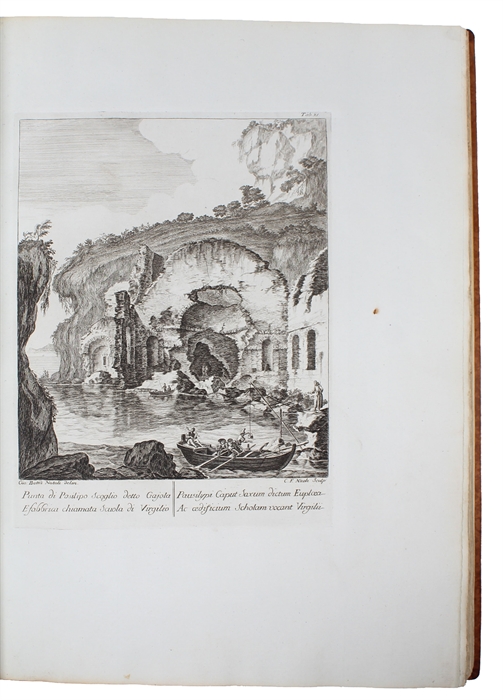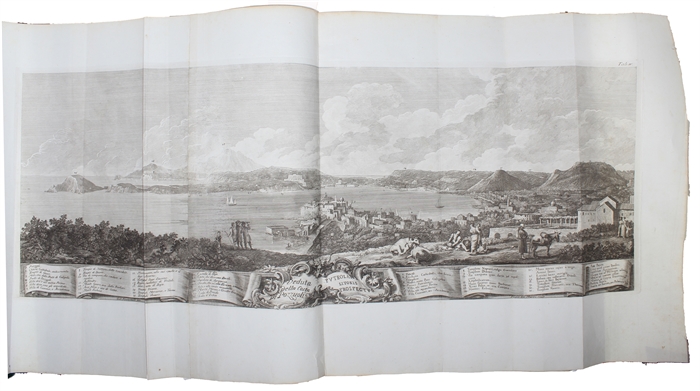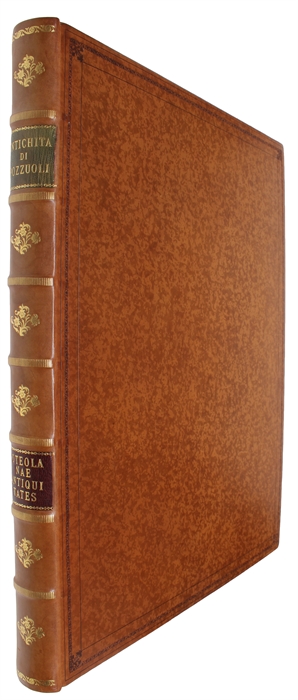A MASTERPIECE OF 18TH CENTURY ITALIAN CHALCOGRAPHY
PAOLI, PAOLO ANTONIO.
Antichita di Pozzuoli. Puteolanae antiquitates. Avanzi delle antichita esistenti a Pozzuoli, Cuma e Baja. Antiquitatum Puteolis, Cumis Balis existentium reliquiae.
(Napoli, 1768).
Folio. Bound uncut in a magnificent recent sprinkled full calf pastiche-binding with seven raised bands, forming eight compartments. Two leather title-labels to spine and compartments and raised bands with gilt ornamentation. All edges of boards with blindstamped decorations. One text leaf (unnumbered, but no. 38) with small stain and one diagram with tiny hole measureing 1 cm2, both far from affecting text/plate, very light soiling to first two leaves. All in all a very fine, clean an attractive copy. Complete with 39 ff. of text [Italian and Latin in parallel columns], 69 plates of views and diagrams of which three are double page and one folded, a beautiful panorama depicting the Bay of Pozzuoli ('Veduta della Costa di Pozzuoli').
The rare first edition of Paoli's masterpiece of 18th century Italian chalcography with both text and views in beautiful copper engraved plates. The systematic documentation of classical ancient Greek and Roman ruins, many of which are here depicted for the very first time, is considered the most important eighteenth century views of Pozzuoli and its surroundings.
The engravings by Giovanni Volpato, Antoine Cardon, Francesco La Marra, and Johann Dominik Fiorillo are based on drawings by local artists such as Gianbattista Natali, Tommaso Rojola, Ricciarelli and Magri. Conte Felice Gazzola commissioned the present work and when published, it was printed in very few copies only and sold for 15 Neapolitan ducats. A second edition in folio-oblong was printed in 1769.
Pozzuoli, located just north of Naples, began as a Greek colony and a Roman colony was established in 194 BC. Pozzuoli (at the time named Puteoli) was the great emporium for the Alexandrian grain ships and other ships from all over the Roman world. It was also the main hub for goods exported from Campania, including blown glass, mosaics, wrought iron, and marble. The Roman naval base at nearby Misenum housed the largest naval fleet in the ancient world. It was also the site of the Roman Dictator Sulla's country villa and the place where he died in 78 BC - the ruins of many of these sights are portrayed in the present work.
Paolo Antonio Paoli, president of the Pontifical Ecclesiastical Academy in Rome (1775-98), was a pioneering scholar and historian of the ancient civilizations of the region of Campania in southern Italy.
Cicognara 2692 (erroneously dated 1778)
Graesse I, 146
Brunet I, 314
Order-nr.: 54196




